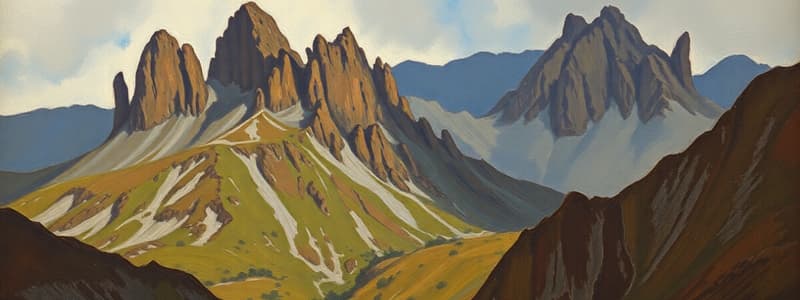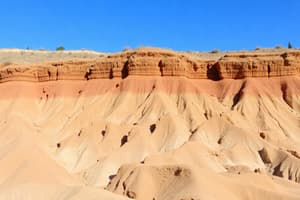Podcast
Questions and Answers
What primarily causes erosion?
What primarily causes erosion?
- Volcanic eruptions
- Meteor impacts
- Tectonic movements
- Wind and water action (correct)
What is meant by deposition?
What is meant by deposition?
- The process of eroded materials being deposited (correct)
- Continuous weathering of rocks
- The wearing away of surfaces
- The movement of tectonic plates
Which of the following is a significant factor in day-to-day weather variations?
Which of the following is a significant factor in day-to-day weather variations?
- Geological age
- Humidity (correct)
- Seasonal temperature changes
- Tectonic uplift
How does climate differ from weather?
How does climate differ from weather?
What type of weather phenomenon falls under precipitation?
What type of weather phenomenon falls under precipitation?
Which process contributes to new land formations?
Which process contributes to new land formations?
Which of the following describes tectonic movement?
Which of the following describes tectonic movement?
What role do volcanic eruptions play in geological processes?
What role do volcanic eruptions play in geological processes?
What is a landscape primarily composed of?
What is a landscape primarily composed of?
Which of the following is not a type of landform mentioned?
Which of the following is not a type of landform mentioned?
What do weathering and erosion contribute to in terms of geography?
What do weathering and erosion contribute to in terms of geography?
Which of the following is a characteristic of riverine landscapes?
Which of the following is a characteristic of riverine landscapes?
What distinguishes individual landforms from landscapes?
What distinguishes individual landforms from landscapes?
How do we define landforms?
How do we define landforms?
What event is highlighted in connection with its effects on landscapes?
What event is highlighted in connection with its effects on landscapes?
Which term describes the boundaries where two tectonic plates meet?
Which term describes the boundaries where two tectonic plates meet?
What term describes the upper limit of the zone where groundwater fills pore spaces?
What term describes the upper limit of the zone where groundwater fills pore spaces?
What is the primary mineral found in limestone responsible for its solubility in water?
What is the primary mineral found in limestone responsible for its solubility in water?
Which process contributes to the development of karst landscapes?
Which process contributes to the development of karst landscapes?
How does groundwater primarily circulate within rock or sediment?
How does groundwater primarily circulate within rock or sediment?
What happens to surface water when it enters bedding and joint planes in limestone terrain?
What happens to surface water when it enters bedding and joint planes in limestone terrain?
What can be formed as groundwater eventually emerges from underground flows?
What can be formed as groundwater eventually emerges from underground flows?
In karst landscapes, what role does the water table play?
In karst landscapes, what role does the water table play?
What type of underground water flow is responsible for contributing to the formation of landforms in karst regions?
What type of underground water flow is responsible for contributing to the formation of landforms in karst regions?
How much does the Himalayas mountain range grow each year?
How much does the Himalayas mountain range grow each year?
What is the meaning of the term 'Nullarbor'?
What is the meaning of the term 'Nullarbor'?
What geographic region has the majority of the Nullarbor Plain?
What geographic region has the majority of the Nullarbor Plain?
Which volcanic eruption was the largest during historical times?
Which volcanic eruption was the largest during historical times?
How high did the ash from the Tambora eruption reach?
How high did the ash from the Tambora eruption reach?
What significant amount of sulfur was released during the Tambora eruption?
What significant amount of sulfur was released during the Tambora eruption?
What can be said about the status of the Tambora volcano before 1815?
What can be said about the status of the Tambora volcano before 1815?
What volume of dense rocks was ejected during the Tambora eruption?
What volume of dense rocks was ejected during the Tambora eruption?
What causes a shaped depression in a volcano?
What causes a shaped depression in a volcano?
What was the elevation of Tambora before the eruption?
What was the elevation of Tambora before the eruption?
How much did global temperatures reportedly drop due to the eruption?
How much did global temperatures reportedly drop due to the eruption?
What was a notable physical effect of the volcanic eruption on surrounding areas?
What was a notable physical effect of the volcanic eruption on surrounding areas?
What phenomenon occurred in places like London following the eruption?
What phenomenon occurred in places like London following the eruption?
What was the impact of the eruption on food and water availability?
What was the impact of the eruption on food and water availability?
What was the estimated number of people who died due to the eruption or its immediate aftermath?
What was the estimated number of people who died due to the eruption or its immediate aftermath?
What catastrophic event occurred alongside the volcanic eruption?
What catastrophic event occurred alongside the volcanic eruption?
Flashcards are hidden until you start studying
Study Notes
Landscapes and Landforms
- Landforms are individual features of the Earth’s surface identified by their shape, such as dunes, plateaus, canyons, beaches, plains, hills, rivers, and valleys.
- Landscapes are a combination of these landforms, geological, geomorphological, biological, and cultural layers that have evolved over time.
- Examples of landscapes include riverine, coastal, and urban landscapes.
- Weathering is the wearing away of the surface of the Earth by the action of wind and water.
- Erosion is the process of eroded material being deposited.
- Constructive forces contribute to the formation of new landforms through volcanic eruptions, tectonic uplift, and the deposition of sediments.
- Destructive forces wear down landforms through weathering and erosion.
- Tectonic plates are large segments of the Earth's crust that move and float.
- Collision plate boundaries occur when two tectonic plates collide.
- The Himalayas mountain range formed as a result of a collision between the Indo-Australian Plate and the Eurasian Plate.
Karst Landscapes
- Karst landscapes are characterized by caves, fissures, and unique environments.
- They form when water infiltrates the Earth's surface and saturates the ground.
- The water table is the upper limit of the zone of saturation.
- Groundwater moves more slowly than surface water, circulating through small spaces within rock or sediment.
- Groundwater contributes to the formation of karst landforms.
- In limestone terrain, bedding and joint planes allow surface water to enter and dissolve calcite, creating caves, springs, and rivers.
- The Nullarbor Plain is the world's largest limestone karst landscape, covering 270,000 square kilometers.
Volcanoes
- Volcanic eruptions can create new landforms or reshape existing ones.
- Tambora, a volcano in Indonesia, erupted in 1815, causing the largest volcanic eruption in historical times.
- Approximately 50 cubic kilometers of dense rock were ejected during the eruption.
- Before the eruption, Tambora stood at about 4,300 meters, but the summit exploded creating a caldera measuring 6 km wide and 1 km deep.
- The eruption released 60 million tons of sulfur, large amounts of fluorine, and massive pumice flows.
- The eruption caused tsunamis, building collapses, and air temperatures to drop dramatically, resulting in a “year without a summer” in 1816.
- The eruption affected global temperatures, causing a drop of up to 3 degrees Celsius.
- At least 71,000 people are estimated to have died during the eruption or immediately afterward.
Studying That Suits You
Use AI to generate personalized quizzes and flashcards to suit your learning preferences.




